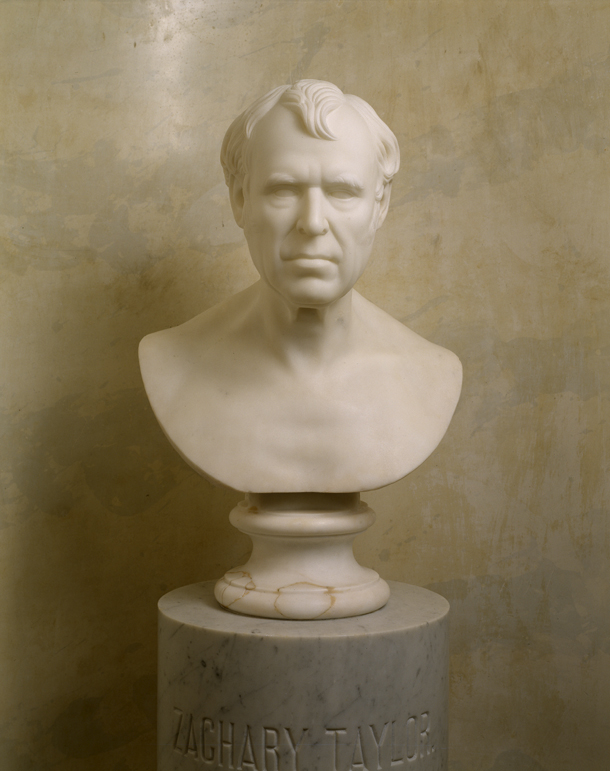
| Title | Zachary Taylor |
| Artist/Maker | Unidentified |
| Date | 19th century |
| Medium | Marble |
| Dimensions | h. 19.75 x w. 15.38 x d. 11.13 in. (h. 50.2 x w. 39.1 x d. 28.3 cm) |
| Credit Line | U.S. Senate Collection |
| Accession Number | 21.00019.000 |
In 1904 John Taylor Wood contacted the chairman of the Joint Committee on the Library, Senator George Peabody Wetmore, offering to sell the bust of his grandfather Zachary Taylor. “This Bust was given to me by my mother, eldest child of President Taylor, who married General Robert Crooke Wood, Surgeon-General U.S. Army. As far as the family know[s] it is the only one extant of him,” wrote Wood in a letter. He further noted: “All agree it is a most excellent likeness; could not be excelled; the work of a talented sculptor. But strange I have no record of the artist nor have I been able to obtain his name.”
Several bills on the subject were introduced and reported in the Senate, but no floor action took place until 1909. At that time, the committee purchased the bust of Taylor from Lola Wood, widow of John Taylor Wood. The committee paid Lola Wood $2,000, drawn from funds specifically designated for that purpose in the Sundry Civil Expenses Act, approved March 4, 1909.
As John Wood reported, the identity of the sculptor is not known. The likeness of Taylor in the Senate’s portrait bust is, however, similar to that appearing on a commemorative medal authorized by resolution of Congress on May 9, 1848, to recognize Taylor’s Mexican War victory. The miniature portrait in profile was engraved by Charles Cushing Wright from a bas-relief portrait by Salathiel Ellis. Known as a sculptor of cameo portraits, Ellis designed several medals for the United States Mint, including those honoring Millard Fillmore, Franklin Pierce, James Buchanan, Abraham Lincoln, Winfield Scott, and Cornelius Vanderbilt.
Zachary Taylor, the 12th president of the United States, was born in Orange County, Virginia. Taylor's long military career began in 1808, when he became a first lieutenant in the United States Army's 7th Infantry. Nicknamed "Old Rough and Ready," Taylor was assigned to frontier posts during the War of 1812 and remained there during much of his army service. As a colonel he took part in the Black Hawk War and later won wide popularity as a general in the Mexican War. Despite his successes in the Mexican campaign, he was often in conflict with the administration of President James Polk. In 1847 Taylor disobeyed orders by going on the offensive against the Mexican leader Santa Anna, whom he defeated at the Battle of Buena Vista. A popular hero, Taylor was nominated for president in 1848 by the Whigs on the first ballot (over Henry Clay, Daniel Webster, and Winfield Scott).
Taylor defeated Lewis Cass in the general election and became president at a time of great sectional discord over the extension of slavery. Taylor favored a plan that would result in the admission to the Union of California and New Mexico as free states, despite the objections of Southern Whigs, and he remained inflexible in the face of secessionist threats. Taylor died in office before passage of the Compromise of 1850 measures. The outstanding achievement of his administration was the Clayton-Bulwer Treaty of 1850, which gave Great Britain and the United States joint control over canal rights at the mouth of the San Juan River in Central America.